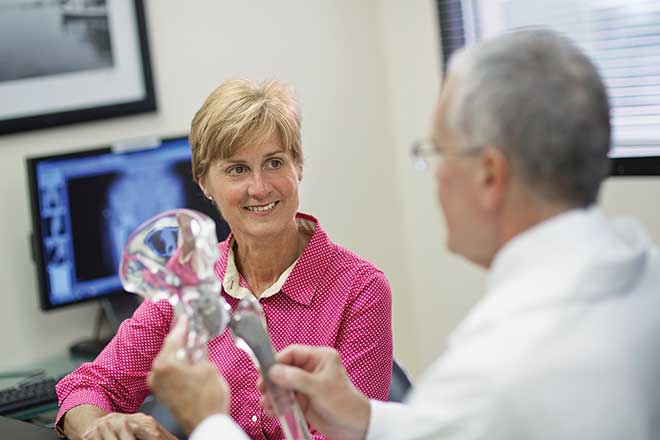By age 50, Julie Binder’s rheumatoid and osteoarthritis caused so much pain in her hips that she couldn’t ride a bicycle without limping for days afterward. “I was on medications and had injections in the hip, but they weren’t helping anymore,” says the Columbia, Illinois, resident. “If I rode, I’d be down for the count for quite a while.” After three years of waiting out the pain, Binder finally sought help from SLUCare Orthopaedics’ joint replacement program. She had one hip replaced in 2012 and the other earlier this year. “The pain was gone immediately,” she says. “I didn’t realize how much energy had gone into coping with pain. Being freed from having to think about my hips was great.”
Improvements in arthritis treatments have helped reduce the number of middle-aged people needing joint replacements, and the procedure is now most common among people in their 60s and 70s, Whiting says. “Implants wear better and last longer than ever before,” he notes. “Although we hope they will last 30 years, we try to get patients as old as possible before replacement so the implant can last the rest of their lives.”
These surgeries typically requires a two- to five-day hospital stay, Whiting says. After surgery, patients use their new joints right away. Physical therapy starts in the hospital and continues for one to three months afterward to improve range of motion and strength. “Recovery times vary by individual,” Whiting says. “It can take anywhere from four to 12 weeks to get back to work and resume normal activities; healing fully can take up to a year.”
Although joint replacement isn’t a quick-and-easy fix, patients who’ve been through it typically think it’s worth the lengthy recovery, he says. “The thing we hear the most from patients is they wish they hadn’t waited so long,” Whiting says. “Most patients feel markedly better, and they can enjoy their lives again.” Just a few months after her second hip replacement, Binder is already able to do many of her favorite pre-arthritis activities, including biking. “I wondered if I could ever ride again, but within two months of my last surgery, I was on my bike.” She is leaving soon for a sixday ride across Mississippi. “It was always a dream trip, but I never thought I would be able to do it. Now that both my hips are working, I have so much more energy to attack life.”
Pictured: Julie Binder and Dr. Thomas Otto of SLUCare Orthopaedics
Cover design: Jon Fogel
Photos courtesy of SLUCare Physician Group
[SLUCare Orthopaedics’ Joint Replacement program, located at 1031 Bellevue Ave., Ste. 280 A, offers specialized care for joint replacement surgery to help people with bone disease and joint problems live with greater mobility and independence. Pictured on the cover: Orthopedic surgeons Dr. Thomas Otto, Dr. Scott Kaar and Dr. Jeff Whiting. For more information, call 314.768.1050 or visit slucare.edu/jointreplacement.]
